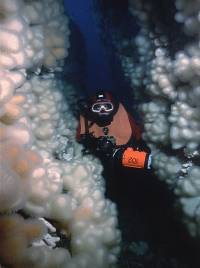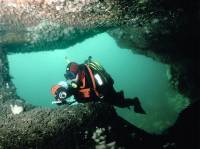 |
|
|||||||||||||||||||||||||||||||||||||||||||||||||||||||||||||||||||||||
|
||||||||||||||||||||||||||||||||||||||||||||||||||||||||||||||||||||||||
|
|
||||||||||||||||||||||||||||||||||||||||||||||||||||||||||||||||||||||||
|
||||||||||||||||||||||||||||||||||||||||||||||||||||||||||||||||||||||||
|
The outstanding scenery of the Berwickshire coastline extends much further than a coastal walker might imagine. Although the cliffs stand in places around 100m high, they also extend up to another 30m below the sea. And if anything, their shape and form is even more dramatic than on land The rocks of St. Abbs Head are primarily a combination of soft red sandstone and much harder volcanic upthrusts. Because the headland juts out significantly into the North Sea, it forms a major obstruction to the tidal flow. Twice a day in both directions, the pent up water pours round the headland. This movement, coupled with the action of the waves and swell when the sea is rough, has over aeons of time, carved walls, tunnels, gullies and archways that form some of the finest underwater scenery around the British coast. Typical of this, just a short swim from the harbour wall at St. Abbs, an insignificant, seaweed covered rock shows above the water at about half tide. It gives no hint of what lies below the surface and before divers came on the scene it was known to the local fishermen as the Sluts. Nothing could be more inappropriate and by common consent, it is now universally referred to as Cathedral Rock - a huge arch rising from the sea bed in which you could park a double deck bus with room to spare! Above it is a smaller flatter arch which a diver can swim through comfortably. The walls are covered in an amazing range of encrusting marine life and when the sunlight pours through it, it makes a marvellous spectacle. This rock coupled with other excellent dive sites just off the harbour wall has led to this becoming the most popular shore diving site in Britain. Text and Images by Jim Greenfield.
|
|
||||||||||||||||||||||||||||||||||||||||||||||||||||||||||||||||||||||
|
St. Abbs & Eyemouth Voluntary Marine Reserve. |
||||||||||||||||||||||||||||||||||||||||||||||||||||||||||||||||||||||||



